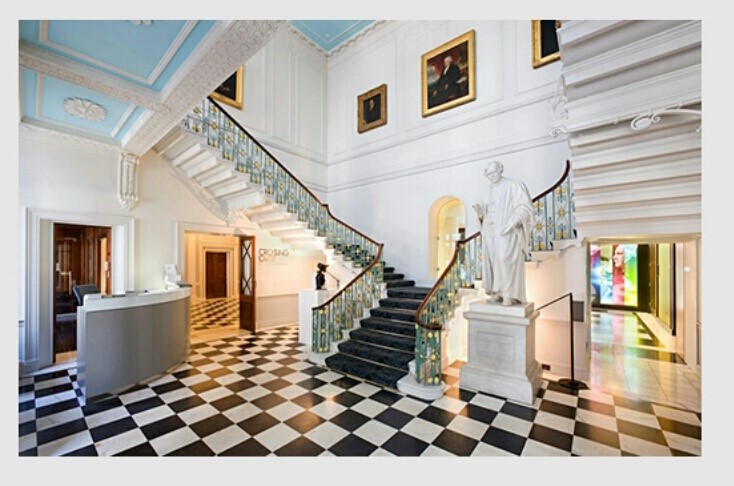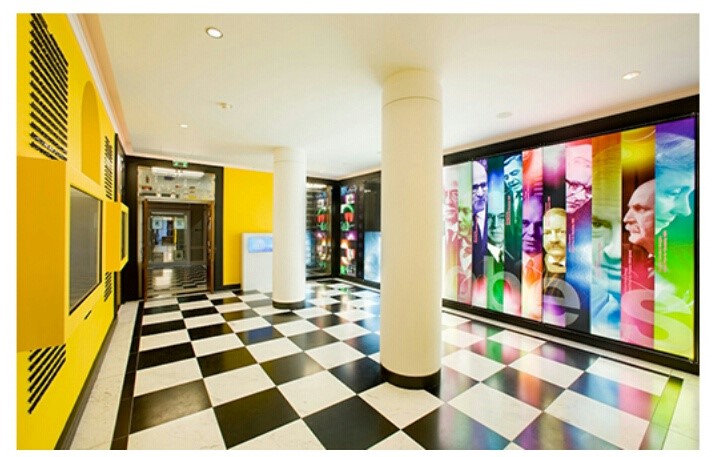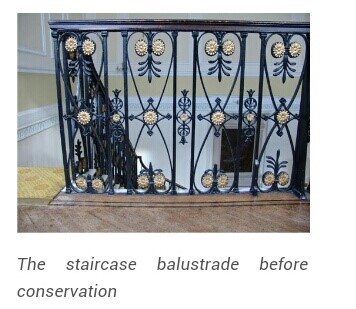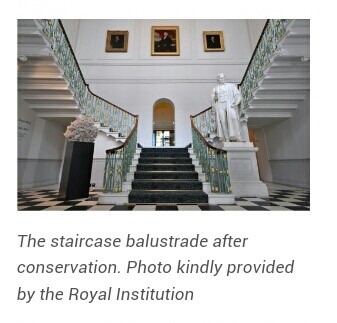
The Impact of Technological Advancement on Construction Industry
December 21, 2020
BUILDING SURVEYING
December 21, 2020Executive Summary
This study aims at evaluating the conservation work performed for a listed building in the UK with regard to the various guidelines and principles defined for the preservation of sites and buildings that are of archaeological and historical significance. The different statutes and related legislative frameworks defined by the UK government for the protection of the cultural and historical significance of the buildings are analysed. The chosen listed building for the evaluation of conservation work is the Royal Institute of Great Britain in London, which serves as a central scientific hub for learning and research for people across the globe. Conservation and repair work to protect the heritage and cultural value of this national asset was carried out in 1995 and recently in 2008, which is evaluated with reference to established principles for conservation work.
Question 1: Explain, with reference to relevant statutes and policies, how the legislative framework operates to ensure that the historical significance and public value of the selected building are maintained.
Conservative work on a building facilitates the sustainability of the built environment, ensuring a greener place for generations to come. The conservation principles are defined to ensure that a building or structure is helpful to the community and its surrounding environment providing benefits to the national economy and the community serving as a strategic unit of historical and cultural significance. There are various conservative policies and legislation related to the different kinds of work involved with the conservation or preservation of the building or site.
Typically a listed building is one where conservation work needs to be done, the site has been built before 1948 and where the site holds value in terms of historical and cultural significance. Such listed buildings are maintained to obtain use related to heritage sustainability and contribution to economic development. For a listed building to be repaired, altered, demolished or expanded, general consent has to be obtained from the City council to start conservation work on the site. In the UK, there are many sites that reflect cultural significance and are historically important being a means of attracting tourists from all across the globe, providing value to the tourism industry and driving the UK economy (Bernard, 2003)
The government in the UK has paid considerable attention to the tourism industry, specifically to preserving sites of cultural and historical importance. There have been policies and laws defined to ensure conformity to conservation principles before any alteration or repair work is planned and executed for a building. This paper also highlights the conservation work performed in a listed building in the UK. It provides a critique on how it conforms to the conservation principles and guidelines established for building conservation.
The selected building listed for this paper is the Royal Institute of Great Britain in Westminster, which dates back to the 1838 era and was repaired in 1995 with most of its unique features and assets retained. Significant alterations and repair work were recently done in 2008 in consultation with the English Heritage and after a review report of the conservators. The Royal Institute is one of the most popular places of cultural importance in Great Britain, a place where Micheal Faraday gave his famous lecture in the late nineteenth century. The building has been listed as Grade 1, and conservation work has made an essential contribution to its popularity and heritage as a tourist attraction and a place of national significance (Gwendy, 1985).

Figure 1: Royal Institute - Gallery (ISG plc, 2016)
The basic legislation related to building and development planning is Section 54A of The Town and Country Planning Act 1990, as defined by the City Council and the UK government, which allows the council to review and undertake planning for development projects. For conservation work and listed building control, the city council will review alteration, repair work and other necessary conservation work in conformity with the unitary development plan, UDP, for maintaining sites that hold significant value historically and culturally according to section 66 of the Planning (Listed Buildings and Conservation Areas) Act 1990. The Royal Institute of Great Britain, under the vigilance of the city council, has been listed as a Grade 1 building and conservation work undertaken has conformed with this Planning Act 1990 (Supplementary Planning Guidance, 2016)
The government, therefore, grants the City Council permission and assent as per defined statutes and legislation to make efforts to preserve old monuments and buildings of cultural and historical significance. The DES 8(A) framework provides details for the protection and safety of the sites that possess an archaeological interest, whereby the City Council is responsible for the preservation and conservation of historically significant features, fabric and assets of the building. The Royal Institute in Great Britain was extensively conserved in 1995, with alterations and repair work done to retain historic features like materials, brickwork, Metalwork and the general character of the site. The aim was to preserve and protect this national asset that holds cultural and historical value serving as a science hub for tourists and researchers all across the globe.
The article DES 8(C) of the Planning Act 1990 pertaining to the listed buildings and conservation areas provides details about the change of use related to the historic building. The City council reviews applications for the new utility of the building provided that its repair or alteration is within the principles of the development plan and that the new use does not affect the historical value of the building. Over the years, the Royal Institute of Great Britain has been expanded and altered to enhance its cultural value and utility over the long term. The institute consists of the Faraday Museum, Library and the high-tech theatre, among other features that enable it to be used for scientific research and learning. The multiple uses of this historic site conform to the highlighted legislation, and repair work was carried out in accordance with the English Heritage consultation and City Council consent.

Figure 2: Royal Institute - Theatre (ISG plc, 2016)
The article DES 8 (D) relates to the details of all planned conservation work to be clearly stated in the application for permission to start work that is submitted to the city council for review and consent. All repairs, expansion, demolition or alterations with the complete description and scope of work, including site investigation, must be clearly mentioned. The article DES 8 (E) states the requirements for the conservation work, explicitly providing details regarding the conservation quality, including the use of material, fabric and features for alterations, repairs, expansions and other preservation work applied to the listed building. The Royal Institute was hence repaired, keeping into consideration the historical value, character and ambience of the site, ensuring that most of it was retained through the use of quality materials and fabric closer to the original that can be seen in the metalwork, sculpting, brickwork and material use of the listed site. (Supplementary Planning Guidance, 2016)
Article DES 8(F) states that extensions to a listed building will only be allowed where the requirement strongly justifies the need to retain the site's historical value. Particular labour and professional craftsman should be employed to carry out conservation work. At the same time, Article DES 8(G) describes conditions under which a specific work for conservation that is not within the area of permitted preservation work would be allowed by the city council. During conservation work or while the building is empty, the City council has the authority to request added security mechanisms to protect the listed building and its historical features from theft and damage, as stated in Article 8(H). Development work that is considered detrimental to the preservation of the listed building will not be allowed, as stated in Article DES 8(I). The conservation of the Royal Institute was carried out after a comprehensive review of the work involved and the feedback from conservators and the English Heritage. The City Council also ensures that there is an effective security mechanism in place to protect the listed building and its archaeological features.
Question 2: Provide, with reference to other examples of historic buildings, an informed explanation of the guiding principles and philosophies to be considered when undertaking works of conservation.
According to the Guidebook for Repairs and Alterations to Listed Building, Supplementary Planning Guidance (1995), published and regularly revised by the City of Westminster, the first guiding principle regarding performing any sort of conservation work on a listed building such as repairs, alteration, demolition or expansion requires specific approval or listed building consent. This is defined in the PPG 15, highlighting the criteria for evaluating a listed building application for conservative work. Particular approval or consent from the city council is needed that provides the go-ahead based on assessment factors such as the historical and cultural significance of the monument, building or structure, the general physical attributes of the listed building such as design, materials, assets and location, the contribution of the building to it's surrounding environment and lastly, the benefits that the conservation work would bring to the economy at large and its surrounding environment including the communities that are directly affected by it.
The Trafalgar square monuments, for example, have been preserved, keeping into consideration the guidelines defined by the City council. Floodlights have been implemented recently in the National Gallery and Nelson's column; both are listed as Grade 1. The conservation work for these historically significant buildings shows professional craftsmanship and conformity to conservation principles. (Supplementary Planning Guidance, 2016)
The guiding principles for the particular use of listed buildings state that the structure should facilitate sustainable development and reflect feasibility in terms of economic growth contribution. The buildings that are conserved must serve the purpose that they are preserved to ensure viability regarding cultural heritage and economic contribution. However, some buildings are left without proper use after conservation work and therefore serve no useful purpose deteriorating over time due to negligence. The guidelines clearly state that the listed building must be maintained, especially after conservation work, to retain its value and enhance its feasibility and utility over the long term. In cases where there is no longer a certain utility for a building, it must be altered and designed to serve some other purpose. The PPG 15 guideline states that a feasible use of the listed building must be determined, keeping into consideration the design, materials and fabric of the structure before undertaking conservation work as detailed in the City Council's policy DES8. (WBDG Historic Preservation Subcommittee, 2015)
For the demolition of listed buildings or structures, the guidelines state that only those structures will be allowed to be demolished that cannot serve any particular purpose in their current form and where redevelopment is the only viable solution. Paras 32.16-3.19 of the PPG 15 highlight the requirements under which consent for demolition work may be granted. These factors include the particular structure's condition, a financial estimate of the repairing or maintenance work with regards to its historical significance, the benefits that would arise from its use over the long term, the appropriateness of the actions taken to maintain the building and the viability of other options for the site or building.
The guidelines state that consent won't be granted just because a site developer prefers redevelopment more than retaining the site's historical significance or because the price of the building that the developer purchased the site at was more apt for redevelopment than the maintenance of the existing condition of the structure or historic site. The general city council policy for demolition work is DES 8(B). Applications for demolition work are generally reviewed in consultation with English Heritage, which maintains a list of the conservative projects referred to as the register of listed buildings. (UDP, 2016)
The guidelines with regards to alterations to buildings are also recorded in the planning guide for performing conservation work on listed buildings. According to PPG15, the alteration works to the listed buildings should ensure that the fabric, historical attributes and important features of the structure are maintained and retained. Alterations to such sites should be done to repair damaged parts of the structure, especially the fabric and features of historical and cultural importance.
The aim should be to retain and preserve such features instead of replacing them with modern fabrics. The original features that are missing and hold considerable archaeological significance are encouraged for refurbishment by the City Council, provided they have an authentic missing record. The evaluation for listed building control entails assessing the structure for special features that reflect historical importance, which typically includes the entire interior of the building or, in specific scenarios, just the facade. (WBDG Historic Preservation Subcommittee, 2015)
In alterations to buildings and listed structures, the guidelines state that all concerned stakeholders should show mutual understanding of the need to preserve the character and historical significance of the site. Therefore alterations should be aimed at retaining the building's unique features. There should be minimum alterations in sensitive interior areas to ensure effective conservative effort. Developers should exercise creative imagination and aesthetics to ensure that conformity to requirements such as floor plans, materials, space planning and floor loadings is in place. When doing alteration work or repairs to a listed building, proper materials closer to the original should be used, and quality should be maintained.
An example of repair work is the Grade 1 listed Eris Forms figure that is part of the Shaftesbury Memorial Fountain by Alfred Gilbert (1893). It was repaired many times in the past, especially after the appearance of cracks due to damage in 1990 by Vandals. After complete review for repair work, Eris was sent for repairs that suggested a durable aluminium casting to retain asset value. Eros in 1994 was reinstalled after repair and continues to serve as a symbol of cultural heritage. (Repairs and Alterations to Listed Building, 1995)
Question 3: With reference to relevant conservation principles, philosophies, and appropriate conservation technologies, evaluate the work undertaken for the selected building.
The selected building for conservation work is the Royal Institute of Great Britain, founded by Henry Cavendish 1799, a famous British Scientist and by George Finch, the first president. The institute in London is a place of strategic and historic importance serving as a place for scientific research and development. In 1995 the centre was repaired, and extensive conservation work was carried out. The palatial home of the centre was significantly repaired and redeveloped, maintaining the place's original ambience and historical theme. The building has since then been listed as a Grade 1 building. It was recently refurbished in 2008 with important repairs, a conservation project that had a budget of almost 22 million pounds (ISG plc, 2016)

Figure 3: Royal Institute - Balustrade Staircase before conservation (Rupert Harris Conservation Ltd, 2016)
The aim of the conservation was to expand the institute to enhance its utility as a centre for scientific learning and research. In light of the guiding principles defined in the planning Act 1990, the conservation project was completed in August 2008, largely constituting the redevelopment of the Faraday Lecture Theatre and the accompanying library. The institute also includes a stately home with a public restaurant and other high-tech facilities for research work. The recent conservation work on the building enabled it to serve as the national hub for science and technology.
The city council thoroughly reviewed the redevelopment before its execution for conformance with defined conservation principles, including constructing a five-storey atrium at the back of the institute containing a glass lift serving as the central point surrounded by glass bridges that span the atrium. Reconfiguration of the ground floor, first floor and the lower ground floor was also part of the redevelopment work, with repairs made to the Faraday laboratory and its accompanying labs that are a source of showcasing science exhibitions. Restaurants and a public bar were also constructed for the extension of its utility (ISG plc, 2016).
Special alterations to the Micheal Faraday Theatre included walls restoration, floor panelling, seating arrangement, roof-work and lighting to enhance its archaeological value while ensuring that it conformed to modern architectural trends and served its prime purpose in parallel. Repairs were made to the balustrade staircase made of wrought iron. Before conservation, the Metalwork and casting were in fair condition and required repairs. Hence comprehensive paint and casting analysis were carried out to decide on the best use of materials to preserve the historical value. The staircase was then conserved with bronze re-casting closer to the original while retaining much of the original patterns. After careful deliberation, the paint theme was chosen as a non-original scheme that matched the site's visual aura after the paint analyst's feedback. (Rupert Harris Conservation Ltd, 2016)

Figure 4: Royal Institute - Balustrade Staircase after conservation (Rupert Harris Conservation Ltd, 2016)
The highest quality of materials and professional services of labourers was acquired to ensure that the site retained its historic glory. Where necessary original archaeological features were retained and properly conserved. The conservator developed designs and conservation details in conformity with English Heritage principles with a focus on standard techniques and materials for the preservation of listed buildings. Roman cement repair was applied to the facade, the cornice was repaired with original plaster repairs including replacement, walls were repaired using lathe and plaster while the timber floor panelling was repaired and other panels replaced with decorative themed wallpapers. Throughout the execution of the conservation project, it was ensured that the repair work confirmed defined guidelines.
Question 4: Evaluate the current use of the building and, from a conservation perspective, critically review alternative options for its use.
As defined in DES 8 of the Planning Act 1990 with regards to listed buildings and conservation areas article, the building use should be relevant to its construction and conservation purpose. Buildings should be best used for what they are built for. The Royal Institute of Great Britain in London hosts scientific exhibitions and science programs that impart knowledge and learning to science enthusiasts. Modern high-tech and state of the art research facilities are available to explore technological advancements and gain scientific knowledge. The Institute has a comprehensive library with a plethora of records and books available for science students, researchers and visitors. The Institute is a focal point of attraction for tourists, with places like the Faraday Museum, Theatre, Library, Davy-Faraday Research Laboratory (DFRL) and public cafes, bars and restaurants largely contributing to the UK economy through tourism services (ISG plc, 2016).
Further alternative uses would include expanding the existing structure to include research centres equipped with modern technology for experimentation and driving innovation. However, the building is also serving many functional purposes already, and any further alterations or expansions for alternative use might result in loss of character or the loss of original heritage and archaeological value, something that does not tally with the defined conservation principles and legislative framework.
SECTION 1:
Explain, With Reference To Relevant Statutes And Policies, How The Legislative Framework Operates To Ensure That The Historic Significance And Public Value Of The Selected Building Are Maintained.
The government of the United Kingdom is very keen towards the protection of the cultural assets of the country. The development of a “Listed Building” ideology is a concept that reflects this government concern. Buildings which are on the list by Historic England are those which have unique architecture or historic interest. Building this statutory list cannot be demolished, extended or changed unless there is a special permission from the local planning authority, which grants this consent after consultation with the central government agency. There is an entire system that ensures the original sanctity of the building on the list. Once a building makes its way to this statutory list, this system comes into action to protect its existence and preserve its importance. Manchester Town Hall building was on this list with its roots in 1877. It is a marvel of architect Alfred Waterhouse. Town Hall houses grand ceremonial rooms, one of which is Great Hall decorated by Ford Madox Brown’s Manchester Murals, demonstrating the history of Manchester City. The Town hall is a symbol of Manchester's history and culture. Statues of John Dalton and Barbirolli are placed at its entrance hall. The exterior of the building is a 280 feet clock tower containing Great Abel, the clock bell (Simon & Inman, 2010).
Historic England is a special government body officially designated as the Historic Buildings and Monuments Commission for England to protect the historic environment of England. Its core responsibility is to guard the perservance of the listed buildings and ancient monuments as per central and local government advisory. It is patronised by the Department of media, culture and Sport-DCMS. This can be regarded as a prime legislative body that works to ensure the historic significance of listed buildings in the United Kingdom. It was officially formed under the National Heritage Act 1983 after several modifications were completed in April 2015 with a new name of English Heritage. Listing the building is a first step toward acknowledging its importance of the historic building. A grading system has been developed to categorise them more effectively. There are two kinds of grading systems, Grade I and Grade II. Grade I are buildings of exceptional interest. Manchester town Hall comes under Grade II, stating “particularly important buildings of more than special interest” (Jenkins, 2015).
Conservation and Modification work to any listed building require certain approvals to ensure that the real asset value is intact. Planning Act 1990 of a listed building is a statutory framework with a detailed explanation of each and every action that could be done and could not be done to listed buildings. It legally bound the authorities to act as per historic interest to maintain the public property of national significance. Due to their old architecture, historic buildings need conservation and repair work periodically to keep them safe and attractive to the public and tourists. The conservation of the historic structure not only signifies the cultural history of the region but also has considerable economic benefits. Therefore, historical structures are considered highly significant assets of the country, and much effort is made at the governmental and social levels to ensure these assets' safety and optimum utilisation (Bernard, 2003).
Planning for Manchester Town hall, the focus of this research, began in 1863; the corporation wanted it to be the superior building in the country then. Albert Square was chosen to be the place for construction considering its spacious avenue. Construction began on October 26, 1868, and was completed in 1877 with 14 million bricks ("Details of facades, Town Hall, Manchester". RIBA - Royal Institute of British Architects). Since its inauguration, the building has not been fully upgraded. In 2014, The Manchester City Council shared a report that showed an agreement after thoroughly considering all the aspects of refurbishing the town hall building. The heating and electrical system, windows, stonework and roofs require maintenance and repair. Jeff Smith, Labour councillor of Old Moat ward, that the improvements done to the town hall will complement its transformation, preserving the historic gems and adding to the services they support. A rigid framework and system established by the UK government are solely responsible for keeping the uniqueness of historic assets intact, and it is doing an exemplary job (Manchester Govt official page, 2015).
SECTION 2:
Provide, With Reference To Other Examples Of Historic Buildings, An Informed Explanation Of The Guiding Principles And Philosophies To Be Considered When Undertaking Works Of Conservation.
Works of conservation are regularised by the city council and the local and central government authorities under the principle of the Planning Act 1990. It covers entire steps starting from the evaluation, requirement, methodology, legal consent, and way work should be done. For compliance with the planning Act 1990, supplementary planning guidance for Repairs and Alteration to Listed Building was published in 1995, which undergoes periodic revision and updating. The very first step of conservation activity is to seek consent for it, which is referred to as “Listed Building Consent” under Planning Act. Listed building control is a special kind of planning control which has the duty to protect a building with historical and architectural importance. This is ahead of any other planning regulations that generally apply, as indicated by planning and licensing guide UK Government, repairs and alterations to a listed building, 2015 and manchester town hall complex transformation programme, 2014).
The most valid reason to form such control is
“To prevent the unrestricted demolition, alteration or extension of a listed building without the express consent of the local planning authority or the Secretary of State”, as per the 7th section of the Planning.
(Listed Building and Conservation Areas, Act 1990, LBCA Act).
According to these regulations, executions of any works related to modifications, alterations, demolitions and/or extensions cannot be undertaken unless comprehended/approved by the regularity authority. This is to ensure that the historic interest, architectural relevance (outline, design etc.) and the overall character of the building (such as historic materials, timber, frames etc.) are not affected. According to the 1990 Act section 9, violation of these regulations can result in guilty of an offence. During any conservations, the primary aim of the engineers and the constructors is to ensure that the original fabric is preserved as much as possible, and the materials compatible with the historic fabric are utilised only for the modification/repair/maintenance works. The FENSA Building Regulations part L details such practices in detail. They can be referred to gain further information on how an optimum balance can be maintained between the building conservation and the proposed alterations.
The city council assesses the application for conservation activity of any listed building based on some established factors under PPG 15 that caters to general physical attributes of listed buildings including its material, design, location, historic and cultural importance, and consequent benefits to the economy and public interest and services. There are many historical examples where this system has taken the lead and restored historical assets. In 1989, the original 18th-century panelling was removed from the Paneled interior to the first-floor room at 67 Dean Street Soho. The prosecution imposed a fine of £14,000, and the panel was reinstated. The Royal Institution, Albemarle Street, Mayfair, is listed as a Grade I building. It was repaired in 1995. Extreme caution was taken into consideration to retain the originality. The original material was used, and it was painted in imitation of natural stone. The methodology adopted for this repair work was developed in consultation with English Heritage (Bernard, 2003).
Once the application for consent with all the requisites is sent, the processing of the application begins. Each city council has design officers with expertise in historic buildings. Consent applications are dealt with by them, who review them critically, visit the place, evaluate the credentials, and prepare an advisory report against the proposed application. The next phase is consultation with all the concerned authorities, including English Heritage, National and local amenity societies and other relevant bodies.
The report is then evaluated for special procedures against The Ecclesiastical Exemption (Listed Buildings and Conservation Areas) Order 1994. Application is assessed against article DES 8 of Planning Act 1990, which demands a clear understanding of the material of construction to be used and the explicit nature of conservation work to be carried out. It requires stated details for every alteration, repair, extension and preservation. After a thorough review, a decision is made. It normally takes six to eight weeks to reach a decision for an appropriate application. According to the Planning (Listed Buildings and Conservation Areas) Act 1990, no conservation act can be done without going through this scrutiny and a series of steps.
SECTION 3:
With Reference To Relevant Conservation Principles And Philosophies, And Appropriate Conservation Technologies, Evaluate The Work Undertaken To The Selected Building.
The selected building is Manchester Town Hall. It was designed in the 13th century in Gothic style but was very innovative as it had an air heating system and fourteen million bricks arranged in Spinkwell stone. In 2010, a process was initiated to repair the Manchester Town hall for its electrical and heating system, along with the roof and windows. A conservative approach was planned to be used for the preservation of as much original fabric as possible. Therefore, much consideration was given to the planning aspect of the proposed alterations.
Alongside, the proposal for refurbishment and expansion was in consideration. An entirely new technique was employed to get this conservation work done. Building Information Modeling (BIM) was new to Manchester City Council, but they wanted the best things to be done for this grandeur asset. This town Hall extension is located in the centre of the city and is a grade II* listed building. Its architecture is known to be the best of its time and exquisite and innovative for its genre. The refurbishment began in September 2010 and was completed in March 2014. The project included redesigning the town hall extension and central library, costing around £100m (Mallett, 2015).
After the approval from the authorised bodies for refurbishment, the following were marked as the core objectives by the Manchester City Council:
- Modify the building energy system to enhance and optimise the operational performance of the heating, cooling and power system of the entire building; to improve the sustainability aspect of the structure
- Enhance the control of the building energy management system
- The BS 5454 conditioned archive spaces within central library archive areas
- Meet Energy saving targets to ensure carbon/energy savings.
The work was completed by a new BIM technique, a flagship project not only for the UK but internationally. It was so unique in its module that it gave the Council utmost confidence that the building is respected. A series of planned and well-informed decisions resulted in very few alterations and restored its originality. Refurbishment of the town hall extension and the central library using the right-first time approach saved significant costs and time. English Heritage and stakeholder consultants were constantly kept in the loop and were informed of the project timeline and progress. Manchester City Council’s operational team was actively a part of all the decisions and supervised the asset information system focusing on the mechanical and electrical data for the building. The BIM technology enabled the evaluation of the isolated chilled water and power and heating systems and added efficiency to the restoration work (Robert Mallett, 2015).

Figure 1: Manchester Town Hall Central Library

Figure 2: Town Hall Extension and Central Library Model
This technique made this refurbishment centre of attraction for the stakeholders. This not only completed the town hall a historic icon but a green building of Manchester. A system has been installed that monitors the energy consumption of the entire building in terms of heat, light and power at 30 min interval and plot this data to a spreadsheet that correlates this consumption to the actual cost. This tool was very effective in gauging the savings and making the building greener. The work completed for the town hall extension and central library earned a reward for its stakeholders and emerged as an exemplary project in restoring the historic building.
The advantages that are obtained by the application of BIM concerning appropriate conservation technologies on this historical architecture are as follows (Mallett, 2015):
- Complex interpolation into an existing structure, creating an interactive demonstration of sequencing and methodology for stakeholders. This developed a clear understanding of the work to be completed among the participating teams and outlined clear objectives, aims, methods/techniques to be adopted, and activity planning. This enables the teams to transfer critical information regarding the structure and ensure that conservation is undertaken as per the requirements of the project.
- Implementation of various design options into a 3D environment using a collaborative client, contractor and consultant team. This facilitated the stakeholders to review/analyse different options/methods of conservation and compare the other techniques, enabling them to select the most appropriate (cost-effective and productive) design and method of conservation.
- Integration of the data into a computer-aided system to analyse all the structural elements of the buildings. This enabled the stakeholder to precisely review the requirements of the building in terms of the changes required, materials to be procured, generate bills of quantities, and in ensuring that the necessary materials are fabricated as per the original fabric requirements of the structure. It also ensured that offsite manufacturing of geometrical elements is exported to its primary design model
- Ongoing project management involves transferring construction data to the client FM team. This ensured that the facilities management team could obtain critical information regarding the complex at any time with high precision. This enables the facilities teams to maintain the building at the required level and undertake optimisation as well as periodic repair and maintenance works as per their requirement
SECTION 4:
Evaluate The Current Use Of The Building, And, From A Conservation Perspective, Critically Review Alternative Options For Its Use.
Town Hall is a tourist attraction. There is a Sculpture Hall to the right of Hall’s main entrance, with statues of notables. As stated by Sir John,
“Amongst the statues are conductor Sir Charles Hallé; Anti-corn Law League campaigners, Richard Cobden and John Bright and the remarkable triptych of celebrated Hallé Orchestra conductor.”
(Sir John Barbirolli)
The current structure has two floors connected with a grand staircase. The second floor of the town hall has some grand halls and staterooms, including The Lord Mayor's Parlor, The Reception Room, The Banqueting Room, The Conference Hall and The Great Hall. Once council meetings were held there, but now Town hall extension is used for this purpose while these halls are currently licensed for wedding events and conferences. The external clock tour tours are arranged for tourists by external tourist organizations. The clock tower is the sixth tallest building in Manchester. Town Hall and Town hall extension hold sanctity for this city. It is a hub of administrative offices that accommodates 3500 working staff that offer direct public service. It is not only a symbol of civic pride but also an emblem of the existence of Manchester City Council. It is also used as a location for television shows and films. There used to be a police station back in 1937, which was reopened in 2014 for public service; unlike traditional police stations with custody cells, it only facilities interviews and administrative tasks (Codinhoto et al., 2013).
After the refurbishment of the town hall extension, there has been a huge shift in the usage of the town hall. Manchester Town Hall is a Grade I listed landmark of global importance and is praised for its extraordinary architecture. The town hall extension and the central library have gone through a historic refurbishment that has changed the way the people look up to the services of the city council. But it didn’t do any good to the Town Hall. A recent report has been published that demand the upgradation of the Electrical and mechanical system of the building along with repairs to the texture. It was assessed that the building needs to undergo maintenance to ensure safety.
Waterhouse's plan for the town hall bridged the gap between ceremonial and office requirements and increased the space on its triangular site. Moreover, the ground-floor Sculpture Hall comprises statues and sculptures of people who are regarded as significant towards the development of Manchester. The landing area comprises the glazed skylight on which the names of lords, mayors, and chairs of the council have been inscribed on glass panes since Manchester received its Charter of Corporation in 1838 (Codinhoto et al., 2013).
The alterations the applied changes made to the building were to homogenise the entire setup. All modifications that have been applied to the town hall exterior should be done for the town hall, and extension in the museum should be done. As per Planning Act 1990’s article DES 8, the listed building conservation should be done to preserve its historic significance and best used for what it’s constructed for. After the town hall refurbishment, it is licensed for weddings and other such events and should be restrained to its core purpose.
Overall it is evident that BIM proved its value in terms of the project as well as all facilities management, and all the objectives which were necessary for making the delivery of services economical, productive and well-organized in less space were successfully achieved. Allowing BIM as the foundation model for the project during design, specification, construction, operation and maintenance proved its value by retaining the structural importance while ensuring it is utilised productively. Therefore, it is recommended that the building use in its current state is viable, hence any major/significant alternate use may not be considered in this case. Only the facilities management must be focused on the way to facilitate the community most effectively and utilise the complete complex for all the purposes that have been accommodated in its latest conservation.
References
Apply the Preservation Process Successfully, WBDG Historic Preservation Subcommittee, 2015. Available from: <https://www.wbdg.org/design/apply_process.php/>.Accessed [25 January 2016].
Bernard, Feilden. Conservation of Historic Buildings, Third Edition (Conservation of Historic Buildings). Architectural Press: July 2003.
Building Codes for Heritage Buildings Heritage Society of British Columbia—Examples of historic building codes and some code exceptions.
Christopher, Brereton. (1991) 'The Repair of Historic Buildings: Advice on Principles and Methods', English Heritage 1991.
English Heritage leaflet: 'London Terrace Houses 1660-1860: A Guide to Alterations and Extensions', 1996.
Eight Guiding Principles in the Conservation of Historic Properties Architectural Conservation Notes. Ontario Ministry of Citizenship, Culture, and Recreation.
Elizabeth, G. Pianca. Smart Codes: A New Approach to Building Codes. Forum News: May/June 2001, Vol.7, No. 5.
Gwendy, Caroe. and Alban. (1985) The Royal Institution : an informal history. London: J. Murray. ISBN 0719542456.
Repairs and Alterations to Listed Building. Supplementary Planning Guidance. Available from: < http://www.westminster.gov.uk/planningandlicensing/udp/index.cfm/>. Accessed [26 January 2016].
Sally, Light. House Histories: A Guide to Tracing the Genealogy of Your Home by Margaret Eberle (Illustrator). Golden Hill Press, September 1989.
Stephen, Emmitt. and David, T. Yeomans. Specifying Buildings, A Design Management Perspective. Butterworth-Heinemann, 2001.
Travis, C., McDonald, Jr. Preservation Brief 35—Understanding Old Buildings: The Process of Architectural Investigation. National Park Service, 1994.
The Royal Institution of Great Britain. ISG plc, 2016. Available from: <http://www.isgplc.com/what-we-do/our-work/leisure/case-study/uk-the-royal-institution-of-great-britain/>. Accessed [26 January 2016].
THE ROYAL INSTITUTION, STAIRCASE BALUSTRADE. Rupert Harris Conservation Ltd, 2016. Available from: <http://rupertharris.com/products/the-royal-institution-staircase-balustrade/>. Accessed [26 January 2016].
Get 3+ Free Dissertation Topics within 24 hours?



























